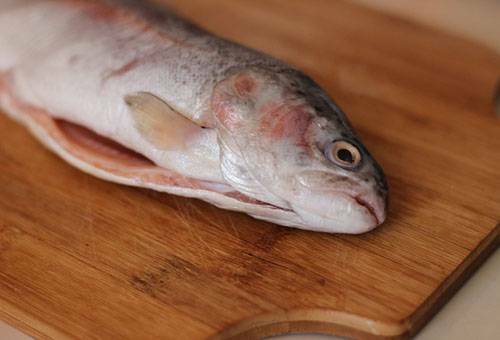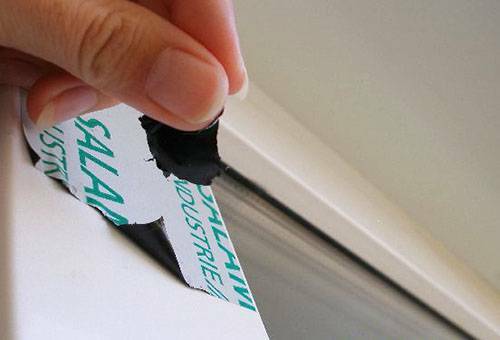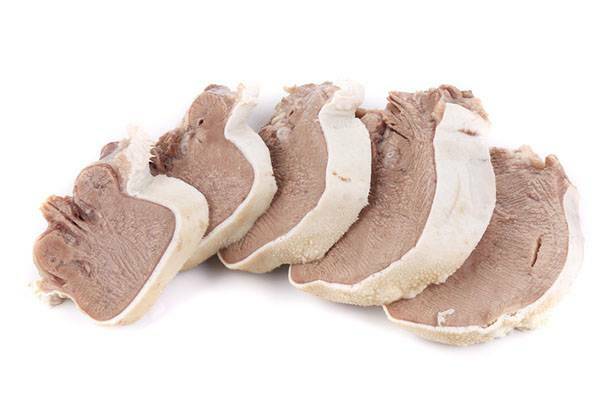Choosing a skateboard is a difficult task for a beginner. Experienced athletes know what they want from the board( speed or maneuverability) and how to achieve it. In extreme cases, they independently collect skate for themselves. But the novice will have to understand the details and look for ready-made compliments. First, decide what you need a skateboard for - to travel around the city and simple pokatushek or for tricks. Then you have to immerse yourself in the study of the characteristics of materials of manufacture and various designs. And only at the very end you can please yourself and concentrate on the design. Complicated? Then we offer a simpler way - our guide to choosing a skateboard.
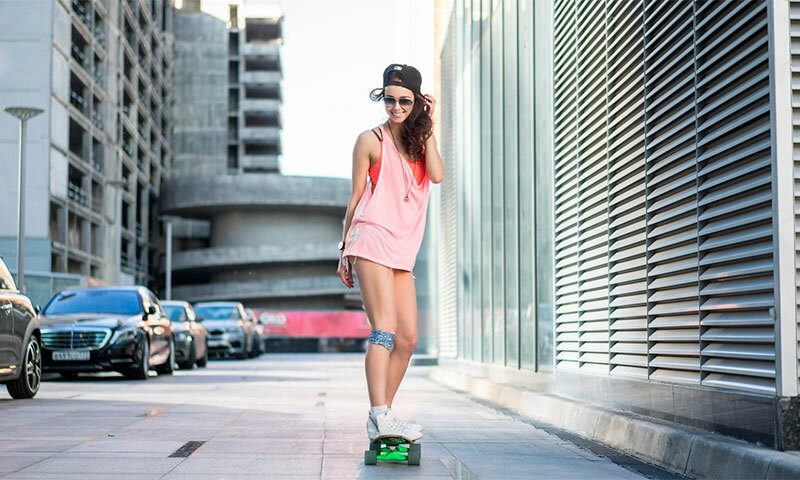
Contents:
- The best manufacturers of skateboards
- The principle and operation of skateboards
- Types of skateboards
- Skateboard selection parameters
- What skateboard to choose
- The cost of skateboards
The best manufacturers of skateboards - which company to choose
If you need a skate urgently( say, as a gift to the daybirthday), and there is no time to understand the design features, you can just look at the board from a well-known manufacturer:
- Zero
- Razor
- HelloWood
- Penny
- Oxelo
The best models of these and other popular companies are represented in our rating of skateboards and longboards. And those who want to buy the perfect board for themselves and not be tormented afterwards with alterations, we advise all the same to become acquainted with the features of its design.
Principle of operation and the device of skateboards
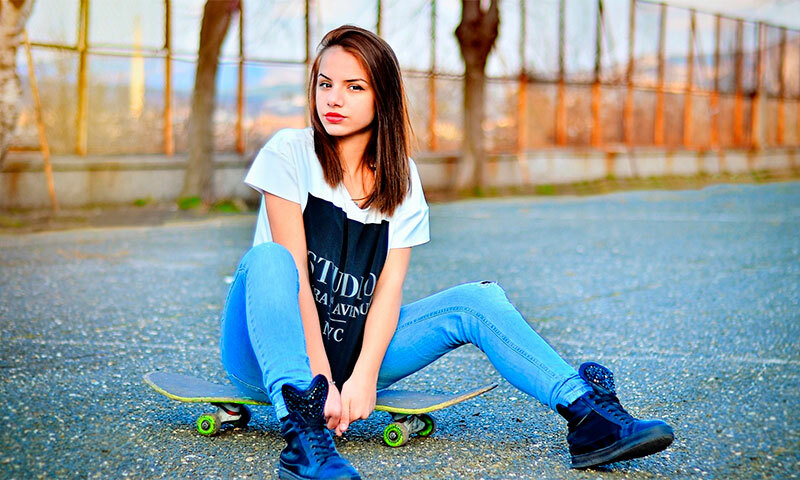
Today the family of skateboards has seriously grown and divided into several groups for different styles of riding. Depending on the board type, its silhouette and some technical characteristics change, but in general the design remains the same:
- The deck is the basis of any skateboard, it can be straight, with a concave( side curvature) bent on one or both sides, whole or segmented.
- Truck is an amortized suspension that is attached to the board through a special pad under the platform.
- Wheels and bearings - running gear.
The main thing that distinguishes one skateboard from another is the shape of the deck. The long one provides good stability, wide - comfort on the road, and curved thanks to the nose and tail( nose and tail) allows you to do various tricks on the board.
Skate maneuvering is provided by trucks. They are designed in such a way that when the lateral pressure is applied, the wheels are rotated in the desired direction. And vibration mitigation provides adjustable shock absorbers suspension.
Types of skateboards
Classic
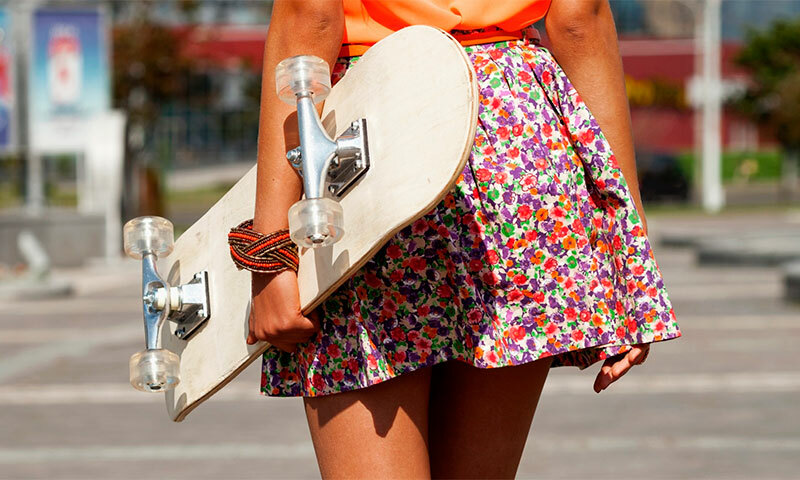
Small board with curved edges and small wheels. Such skates are almost the same length and width with minor deviations of 1-2 inches. Classic models are rarely taken for transport, mostly they are needed to perform feints and tricks.
Pros:
- Good safety factor of the deck;
- Ability to do any tricks;
- Excellent stability;
- Cool design.
Cons:
- Good models are expensive;
- Not very heavy, but for them speed is not the main thing.
Longboard
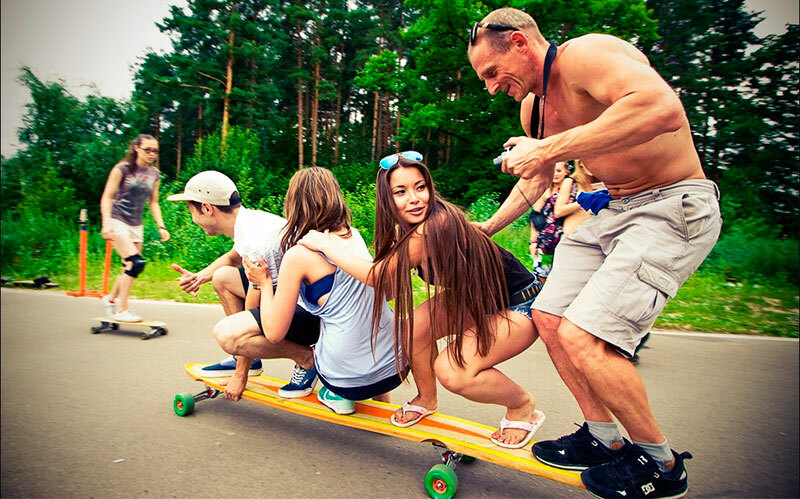
"Long board" - the most accurate name for a skateboard, in which the deck can reach a length of 100-140 cm or more. Here, the front and rear axles are spaced as far apart as possible, and the wheels themselves are large and soft, often peeking along the sides of the boards.
With this design, the longboard becomes particularly stable, it shows itself well at high speeds, although its maneuverability is significantly reduced. But on such a skate it is good to overcome long distances and long descents.
:
- Develops very high speed;
- Maximum stability and stability on the road;
- Can be used as a public transport;
- Long serves.
Cons:
- Dear and rare goods in our stores;
- Heavy weight;
- Tricks on such a board can only be performed by a professional.
Freeboard
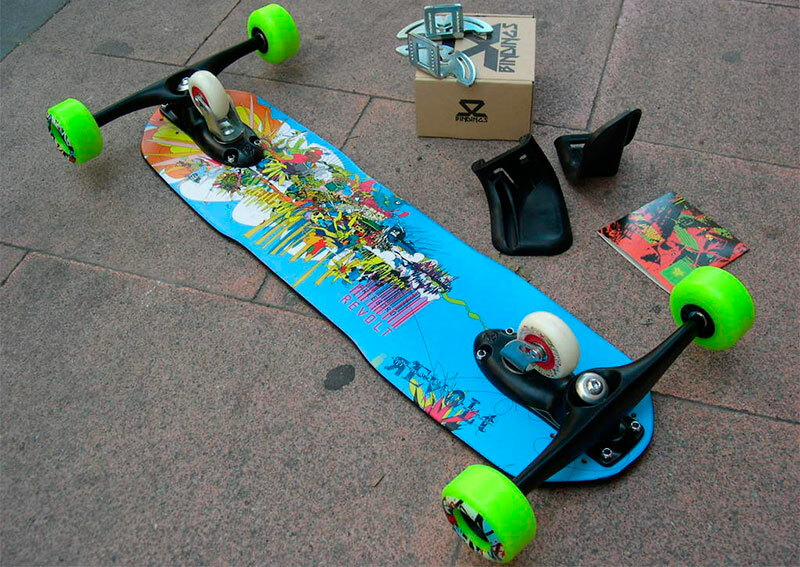
Professional skate with 6 wheels, which are located somewhat wider than usual, was developed on the basis of a longboard. Here in the modified suspension weights are used, which give the whole structure more stability and actually turn the board into a "snowboard for asphalt".
The same purpose is served by a pair of additional wheels - they freely rotate around their axis by 360 °, so that the skate can go in any direction.
Pros:
- Comfortable riding;
- Maximum stability;
- Develops a decent speed;
- Super maneuverable.
Cons:
- Requires special skills - at least snowboarding;
- The length of the deck should be selected strictly according to the growth.
Streetboard( or snowboard)
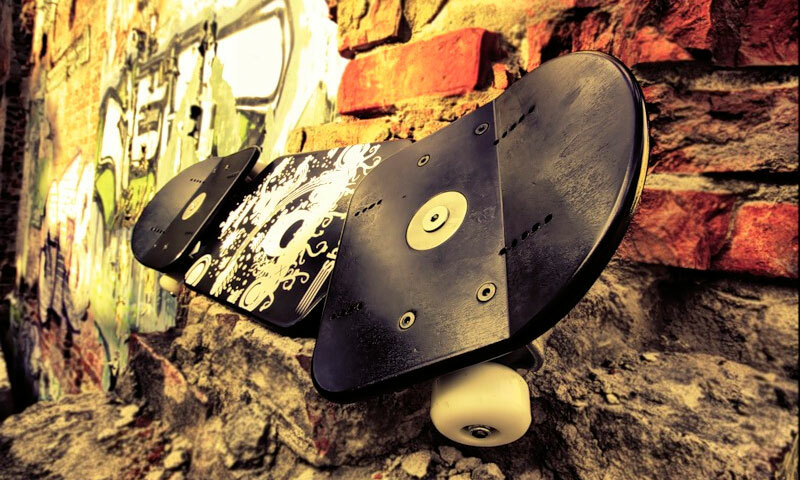
Externally similar to the classic skate, but it is not. The deck of the streetboard consists of three parts: the main stationary and two non-rigidly attached segments. This shell is used for the same tricks as the classic, but thanks to the features of the board has great maneuverability.
Pros:
- Original appearance;
- High maneuverability with good stability;
- You can perform even more tricks and tricks.
Cons:
- Shortlived;
- Not suitable for beginners.
Wavebord and Ripstik
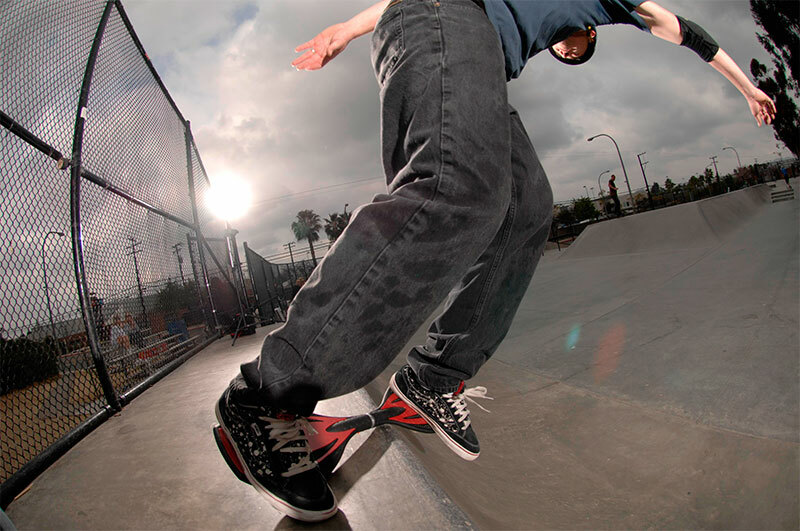
Two-wheeled models, the decks of which consist of two independent parts, connected in the middle by a special torsion mount. These shells do not need to be repelled by a foot - the speed on them is gained by the movement of the body( as on a swing).
Pros:
- Fast overclocking;
- Very high maneuverability;
- Convenient for performing tricks and tricks.
Cons:
- Unstable.
Mountainboard
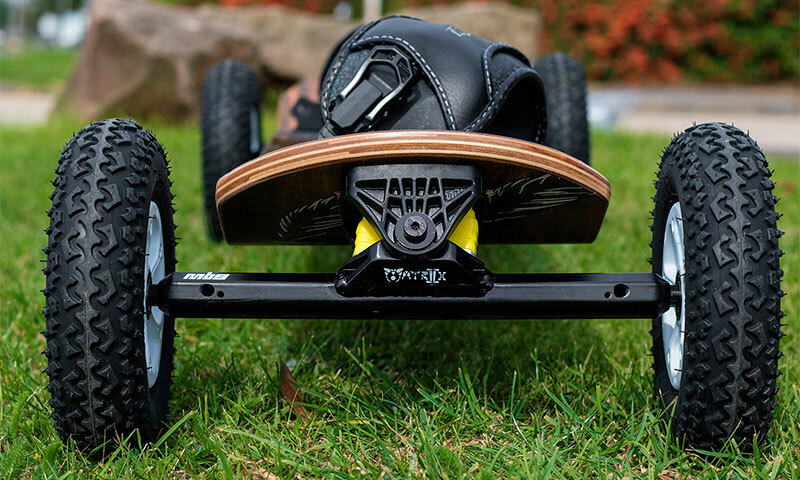
Skateboards for extreme "mountain" skating. Such models have huge inflatable wheels up to 8 ", which allows them to freely ride on the grass and off-road. The length of the deck reaches 1 m, the width is about 30 cm.
Such boards are structurally the same as the others, but they have a powerful spring suspension, foot fittings, and sometimes a motor.
Pros:
- No restrictions when selecting traces;
- Outstanding stability;
- Ideal shock absorption;
- Ability to take lifts with an engine;
- High speed.
Cons:
- High weight;
- Price.
Options for choosing a skateboard
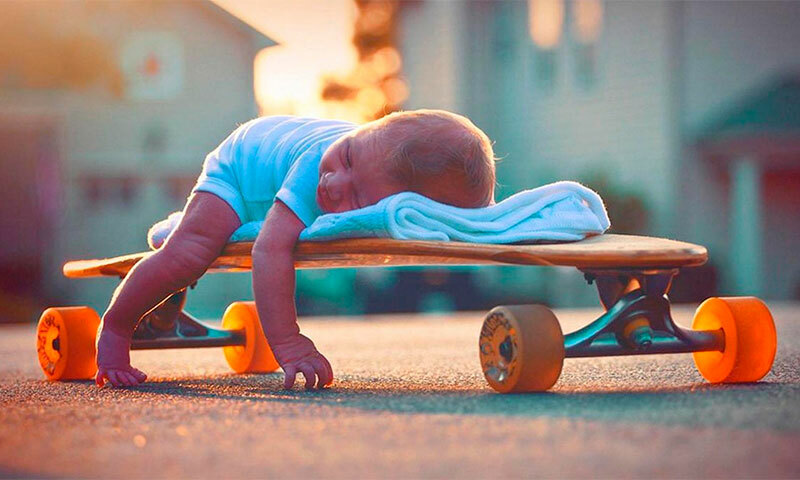
To skate not spoil the impression of riding, and a year later did not have to look for a new shell, when buying, you literally "collect" it in parts:
Deck
With rare exceptions it is made of pressed wood. The number of layers varies from 6 to 9, but the most popular are the seven-layer decks - they are on the market 90%.An important role is played by the selected tree species:
- Canadian( also American) maple is the best choice for skateboarding. It is especially appreciated by professionals for their strength with relatively low weight and perfect elasticity.
- Chinese maple - very little inferior to the Canadian "brother", but if there is not enough money for a cool deck, this option is quite suitable.
- Hardwood - in fact it is not a grade, but a common name for hardwoods that have sufficient strength to arrange conventional pokatushki in the city.
Also the deck can have additional layers, for example, a smooth plastic covering, allowing to slide along the handrails. But this is an optional element of the skate, in contrast to the griptape - skins, similar to sandpaper, which does not allow the legs to slip.
Truck
Here you need strong, but lightweight suspension. Alas, this combination of characteristics is impossible to find. It is necessary to compromise: strong and heavy steel or lightweight but less durable aluminum.
Also pay attention to the dimensions of the tracks - they must be made to the width of the board and have a length of not more than 20 cm.
wheels. In all models except mountainboards, they are made of different hardness polyurethane:
- Soft( 73A to 79A)for a comfortable ride and better control of the board, but quickly wear out.
- Medium( from 80A to 84A) is the "golden mean", which is often found on the compliments.
- Rigid( from 87A to 101A) - they are well typed and keep the speed, they are resistant to abrasion, but they do not completely damp the vibration on the uneven road.
With regard to the diameter of the wheels, then choosing it, you choose the speed of your skate, as well as the ability to drive through difficult sections of the road.
Standard sizes and wheel features:
- 54-60 mm. Very fast and well go even along the cracked asphalt, but steep turns can not be laid on them - it stiffens in the deck.
- 51-53 mm. Not bad show themselves on a rough road surface without cracks and potholes.
- 48-50 mm. The smallest and "slowest" wheels, demanding quality surfaces. They can only be used for skating on concrete or for skateboarders.
The width must also correspond to the quality of the road surface - the worse it is, the more massive the wheels are needed.
bearings Inside each wheel, when putting them on the tracks, 2 bearings of the ABEC standard are embedded. They differ in the class of accuracy of manufacturing, and hence in the speed of acceleration.
The following types of bearings are placed on skateboards:
- ABEC1 - the cheapest and rudely made. They are installed on children's boards and budgetary shells for beginners. For a long time they are not calculated, besides they do not allow to overclock.
- АВЕС3 - standard bearings of middle class with good strength indicators. Developable speed is quite enough for novice skateboarders, amateurs.
- ABEC5 - ideal for daily skating and allow you to easily disperse the board. Most of the good shells are produced with the "five".
- АВЕС7 - have increased complexity of manufacture, therefore belong to a higher price category. Such bearings have the highest accuracy and reliability, and also allow to develop a high speed, for which they are nicknamed racing."Seven" is chosen by experienced skateboarders and professionals who are able to squeeze the most out of any board.
- АВЕС9 - the most expensive bearings, but in our case - not the best option. When this design was created, the developers did not take into account the needs of the athletes and the high loads that the boards experience."Nine" was simply unable to work in such harsh conditions - under the weight of the rider, it quickly deforms and breaks down.
Which skateboard to choose
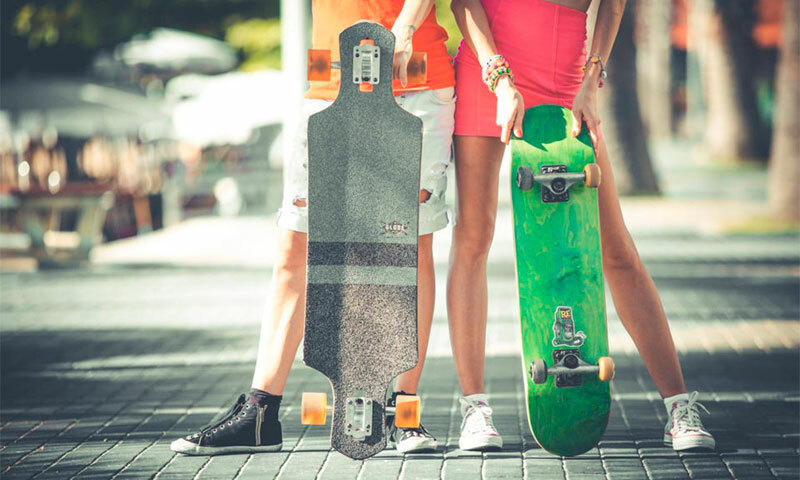
1. For beginners classical skate is suitable, as it is the most convenient for training. It is better to take a board easier - from 7 layers of any solid wood( beech, ash, birch), it is possible with layers of maple.
2. Wheels pick soft, within 78A-84A, so that they keep well on the road and do not slip. Their width will be determined by the quality of the coating on the site, where you will learn how to drive. Here we need bearings of class ABEC3 or ABEC1, if the board is intended for the child.
3. For experienced skateboarders, the classic is also suitable for daily skiing and trimming. But here you will need a more reliable and resilient deck of Chinese maple or with layers of Canadian. Bearings can have a 3-5 grade accuracy, wheels should be chosen slightly above average rigidity - up to 95 A.
4. For high-speed driving and movement around the city, get a longboard. Due to the large size of the board and wheels, you can quickly get to the place. Just look for a good shock-absorbing suspension with wheels of medium stiffness and maximum width, so as to pass unevenly on the asphalt without any problems, and at the same time extend the life of the skate.
5. Experienced riders can even choose a freerboard or straight - their maneuverability in the city will be just the way.
The cost of skateboards

1. Classic shells cost from 1000 to 18000 rubles. Children's models can be taken much cheaper( within 500-2000).
2. Prices for longboards start from 1500 rubles and can reach 25-28 thousand.
3. A good street-card can be bought for 2000-3000 rubles, steep imported models will come out more - up to 25 thousand.
4. The cost of freerboards varies between 13-15 thousand rubles.
5. Waves and ripsticks belong to the same price category - from 2000 to 15000 rubles.
6. For maunting-models prepare to give a minimum of 3000 rubles. If you choose a board without a motor, and from 30 to 60 thousand for a self-propelled variant.

